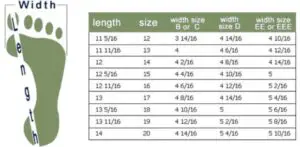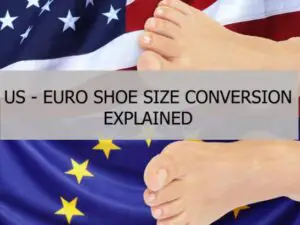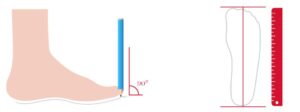A shoe is an essential commodity as well as a form of beauty. But, how about we discuss shoe size. Imagine having a very good shoe concerning material and general look but it does not fit you. This lowers your love for the shoe to zero. Evaluating the shoe size needed when purchasing a shoe is important. Below are the subtopics covered in this article:

- All about shoe size knowledge you should know
- Conversion chart from US size to EU size
- The right way to measure your size and pick a suitable shoe size
Shoe Size Explained
A shoe is measured based on two dimensions. These dimensions are length and width. The longer the foot length the wider the foot. The two essentials are considered to evaluate shoe size.
– Shoe Width
People have different foot width that causes a difference in shoe width. Generally, men put on shoes with a wider width compared to women. Shoe sizes based on width are explained below:
-
‘A’ size
This is the narrowest size that is majorly used by children as well as a small percentage of women.
-
‘B’ size
This type of size applies also to children as well as a large percentage of women. This is derived from the fact that women have narrow feet.
-
‘C’ size
This type of size is dominated by men and a small percentage of women. To men, it is taken as a narrow size.
-
‘D’ size
Just like the ‘C’ size, this size has a large percentage of men. It is from the fact that men have wide feet.
-
‘E’ size
This type of size has an extremely small percentage of people, be it, men or women. It is an extra-large type of size based on width.
Wanting to know more about shoe width, we have explained detailed shoe widths for women, men, and toddlers, check those on our shoe widths explained.
– Shoe Length
Unlike width, the length is a feature that one cannot miss when purchasing a shoe. It is ultimately the first consideration when making any shoe purchase. Below are shoe lengths:
-
Extra narrow size
This shoe length is dominated by infants who have the smallest foot length.
-
Narrow size
This shoe size is dominated by children as well as women. This is because generally, women have small feet.
-
Medium size
This shoe size is dominated by men and a very small percentage of women. This is a narrow size to men.
-
Large size
This shoe size is majorly meant for men. Very few women fall in this category.
-
Extra-large size
This shoe size category has very few people in it. Due to this reason, it is relatively invisible in the market.
Are the US and AUS Shoe Size the Same?
The ultimate shoe sizing is based on US sizing. This US-based measurement is also greatly followed by AUS bringing no difference to both US and AUS.
The US and AUS shoe sizes have a very slight difference. The difference in most cases is a range of 0.5 sizes. For example, a size 5 shoe under AUS is size 5.5 in the US.
US Shoe Size to EU Explained

Shoe size conversation from the US to the EU is relatively a simple algorithm thus easy to understand. You are advised to have this conversion set up in mind. This will help know the size of the shoe be it in a US setup or EU setup. The smallest shoe size as per the US IS 6 while the largest is 15. Below are the sizes of shoes in the US and their conversion to the EU.
| US Size | EU Size |
| 6 | 39 |
| 6.5 | 39 |
| 7 | 40 |
| 7.5 | 40-41 |
| 8 | 41 |
| 8.5 | 41-42 |
| 9 | 42 |
| 9.5 | 42-43 |
| 10 | 43-44 |
| 10.5 | 44-44.5 |
| 11 | 44.5-45 |
| 11.5 | 45-45.5 |
| 12 | 45.5-46 |
| 13 | 46-47 |
| 14 | 47-48 |
| 15 | 48-49 |
This is simple math since you can lower it down to know your shoe size and people around you such as immediate family.
How Do I Measure My Shoe Size At Home?
All individuals, young and old should be aware of their shoe size. It is so disappointing to get home only to realize that a shoe you bought doesn’t fit you. Anger burns within you as your money has gone down the drain. However, this can easily be prevented through steps followed to measure your size at home. These are:

- Get a piece of paper, a pencil, and a ruler. Consider having an A4-sized paper.
- When barefoot, place one foot on the piece of paper placed on a smooth and flat surface with your heel being at the edge of the paper.
- Using a sharp pencil, trace your foot all around.
- Repeat the above two steps with your other foot.
- Measure the length of the foot and this is basically from the paper edge to the longest toe. Measurement should be in centimeters.
- Know the kind of shoe needed from the derived measurements.
Special Tips on Choosing a Suitable Shoe Size
Errors in choosing shoe size inflict one pain the moment you learn about it. This is mainly due to the loss of money and not fulfilling the heart’s desires. Below are tips to ensure you choose the right shoe size:
- Purchase shoes at noon– Feet tend to swell during the day and the noon hour is the best for purchase.
- Use the larger foot to try the shoe before purchase– Our feet are not similar. One of the feet is slightly bigger. This foot is best to try on a shoe.
- Walk around the store with the shoes– Trying shoes out and having an actual walk helps to figure out if the shoe fits you well.
- Consider both the width and length– some shoes might fit in terms of the only length and not width. Ensure that both the width and length of the shoe give you comfort when in it.
FAQs:
#1. What Is the Standard Size of Shoes?
The standard size of shoes is a range of shoe size that holds almost all people in a geographically wide area. Women generally have smaller feet compared to men and this is also relevant in standard sizing. Below are standard sizes for both men and women:
Narrow size: – This kind of shoe sizing is standard for women.
Medium size – This kind of shoe sizing is standard for men.
#2. Is it better to buy shoes bigger or smaller?
Slightly bigger shoes are better than smaller shoes. This is well evident to a child who is still maturing, growing in both height and weight. The growth of the child’s feet is not an exception. A bigger shoe compared to a smaller shoe is better because:
- The smaller shoe can no longer be in use with time– A smaller shoe fully loses its value as one matures.
- A bigger shoe gives space to the feet which is essential– One is comfortable in a shoe that has a small space with it for the feet to be free.
- A bigger shoe serves a longer period than a smaller shoe– On wearing a smaller shoe, the shoe becomes worn out very fast while a bigger shoe continues giving service for long.
#3. What if I am between shoe sizes?
This is a scenario that occurs to most people. It is even more for people such as children who are still growing. To such people, this will eventually change and move out of being between ranges. If it doesn’t, have no worries as this does not impact much. Always size up when in such a situation and don’t size down.
Below are reasons why this is better:
The feet grow in size with time: The feet continue growing especially to children and sizing up helps the shoe to continue fitting.
The shoe is more comfortable than sizing down: In sizing up, you offer a free moving small space and this is healthy. Sizing down might make the feet uncomfortable causing burns and sores.
#4. Does 0.5 size make a big difference in shoes?
The answer to this is 0.5 size is almost equal to nil on the lower side or 1 on the upper side. This is caused by one of the feet being slightly bigger than the other and that is not a problem whatsoever.
When you are in such a situation, choose a shoe that is slightly bigger than your size.
For example, one having a 6.5 shoe size can comfortably put on a shoe that is sized 7.
Using the example given, purchasing a shoe that is size 6 might as well be comfortable but this only goes for a short period. It is therefore advisable to choose a slighter bigger-sized shoe.
Conclusion
Shoe size will always remain to be an important aspect of footwear. It is better to be barefoot than to have a shoe that gives discomfort. Considering both the length and width under shoe size is also ultimately important. The next time you go to a store in need of a shoe take this advice into account. It is free as well as a piece of no-miss advice.
You May Also Need:

